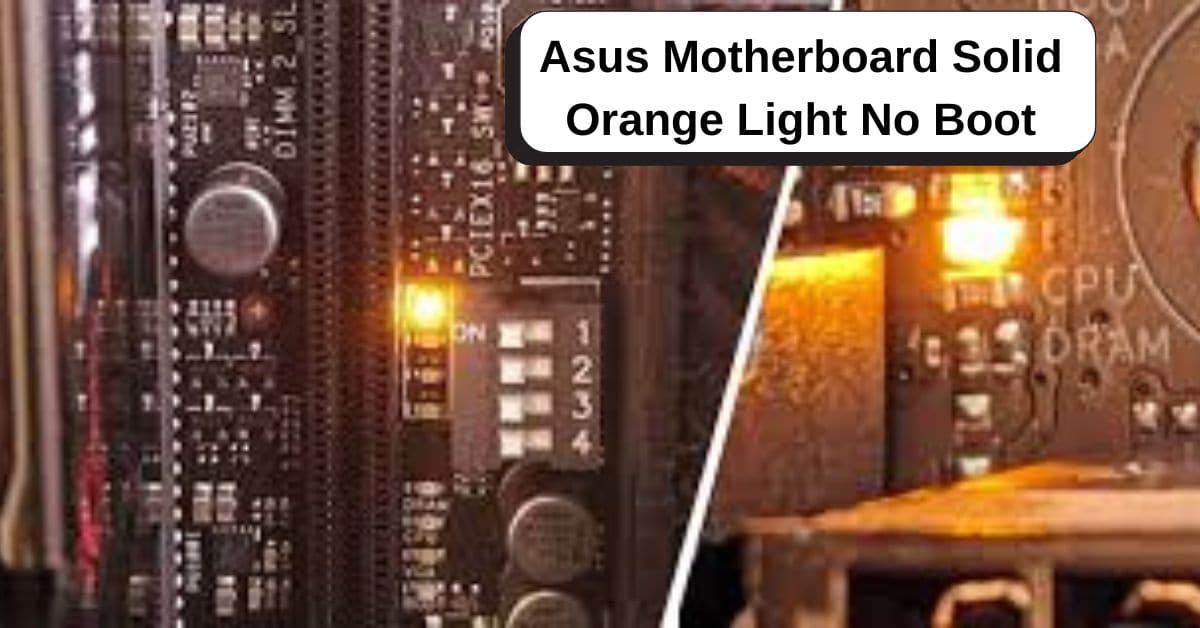A solid orange light on your Asus motherboard, accompanied by no boot, can be frustrating. It’s often a sign of an underlying issue, but with the right approach, you can resolve it.
An orange light on an ASUS motherboard usually means a problem with power or the RAM. Check if all cables are connected properly, the power supply is working, and the RAM is seated correctly. This can help fix no boot issues.
This guide will walk you through the causes and solutions step by step.
Table of Contents
Understanding the Solid Orange Light on an Asus Motherboard:
What Does the Solid Orange Light Indicate?
A solid orange light on an Asus motherboard typically indicates a power-related or hardware initialization issue. This light helps signal that the motherboard is powered but encounters problems proceeding with the boot process.
Power-related Issues:
The orange light may signify problems with the power supply unit (PSU) or improper power delivery to the motherboard.
Hardware Initialization Problems:
It could also mean that one or more components, such as RAM, GPU, or CPU, failed to initialize correctly.
Common Symptoms of the Solid Orange Light Issue:
- No display on the monitor: Despite the power being on, there’s no signal to the monitor.
- Fans spinning but no boot: Fans might run, but the system doesn’t load the operating system.
Causes of the Solid Orange Light Problem:
Faulty Power Supply:
- Insufficient Wattage: If the PSU doesn’t provide enough power for your components, the motherboard won’t boot.
- PSU Connection Issues: Loose or improperly connected cables can disrupt power delivery.
Memory (RAM) Problems:
- Improperly Seated RAM: RAM modules not fully inserted into their slots can trigger the orange light.
- Incompatible Memory Modules: Using RAM not supported by your motherboard can cause initialization issues.
CPU Issues:
- Improper CPU Installation: Misaligned or improperly secured CPUs can prevent booting.
- Damaged CPU Socket Pins: Bent or broken pins in the socket may disrupt communication between the CPU and motherboard.
Motherboard Defects:
- Faulty BIOS Firmware: Outdated or corrupt BIOS firmware can lead to startup issues.
- Physical Damage: Cracked circuits or damaged components on the motherboard can trigger the problem.
How to Diagnose the Issue:
Preliminary Checks:
- Inspecting Power Connections: Ensure all PSU cables are securely attached to the motherboard and components.
- Verifying External Devices: Disconnect peripherals like USB drives and external GPUs to rule out conflicts.
Component Testing:
- Testing RAM Sticks Individually: Remove and test one RAM stick at a time to identify faulty modules.
- Swapping PSU: Try a different PSU to confirm whether the power supply is the culprit.
Step-by-Step Fixes for the Solid Orange Light:
Resetting the CMOS:
Resetting the CMOS can resolve BIOS-related issues.
- Steps to Clear CMOS Battery: Disconnect power, remove the CMOS battery, wait 5-10 minutes, and reinsert it.
- Using the Jumper Method: Locate the jumper on your motherboard and follow the manual to reset.
Checking and Replacing Hardware:
- Re-seating RAM and GPU: Remove and reinsert RAM and GPU to ensure proper connection.
- Verifying CPU and Cooler Installation: Check that the CPU and its cooler are properly seated and secured.
Updating BIOS:
Outdated BIOS firmware can cause boot failures.
- Tools Needed for a BIOS Update: USB drive, motherboard manual, and the latest BIOS file from the Asus website.
- Flashing the Latest Firmware: Use Asus EZ Flash or a similar utility to update the BIOS safely.
Ensuring Proper Cooling:
Overheating components may lead to failures.
- Cleaning Dust: Regularly clean dust from fans and heatsinks.
- Reapplying Thermal Paste: Ensure proper heat transfer by applying fresh thermal paste on the CPU.
Preventing Future Occurrences:
Regular Maintenance Tips:
- Keeping the System Dust-Free: Use compressed air to clean your PC every few months.
- Using a UPS: A UPS prevents power surges that could damage the motherboard.
Using Compatible Components:
- Checking the Asus QVL: Use only components listed in the Qualified Vendor List for your motherboard.
- Avoiding Overclocking: Overclocking beyond limits can damage components and lead to failures.
ASUS motherboard orange light solid?
A solid orange light typically indicates a power-related issue. Check all power connections, ensure the PSU is functioning, and verify that the motherboard isn’t grounding improperly. Clearing the CMOS might also help resolve the issue.
Asus motherboard orange light no display?
An orange light with no display often signals RAM or power problems. Reseat RAM sticks, ensure they are compatible, and verify power connections. Clearing the CMOS can reset settings and potentially fix the display issue.
Asus motherboard solid orange light no boot black screen?
A solid orange light with no boot suggests RAM or power supply issues. Confirm that RAM is properly seated and functional, and ensure your PSU provides sufficient power. Reset the CMOS to clear potential configuration errors.
ASUS motherboard light codes?
ASUS light codes indicate specific issues: red for CPU, orange for RAM, white for GPU, and green for successful boot. These codes help diagnose hardware problems. Refer to your motherboard manual for exact details.
ASUS motherboard orange light blinking?
A blinking orange light suggests unstable power or RAM problems. Check all power connections and RAM seating. Clear the CMOS to reset settings and eliminate configuration-related issues.
How to fix DRAM light on motherboard orange?
To fix the orange DRAM light, reseat RAM sticks, ensure compatibility, and try different slots. Clearing the CMOS or updating the BIOS can also resolve potential memory detection issues.
How to fix orange light on motherboard?
Check power and RAM connections. Reseat RAM sticks, ensure they’re compatible, and try using different slots. Reset the CMOS and verify your PSU’s stability to fix the orange light issue.
DRAM light on motherboard orange?
An orange DRAM light points to memory problems. Reseat the RAM sticks, ensure they match your motherboard’s specifications, and test one stick at a time. Resetting the CMOS can also help resolve this issue.
Why is my ASUS motherboard flashing orange?
Flashing orange light indicates unstable power or memory problems. Check the PSU, ensure stable power, reseat RAM, and clear the CMOS. If the issue persists, test with alternate hardware components.
Why is there a flashing yellow light on my ASUS motherboard and my PC won’t boot up?
A flashing yellow light often signals RAM or power instability. Check that the RAM is properly seated and verify stable power delivery from the PSU. Clearing the CMOS or testing components individually may resolve the problem.
What does a solid orange light mean on ASUS motherboards?
A solid orange light often indicates power or memory issues. Ensure all power connections are secure, the RAM is correctly installed, and the PSU is stable. Resetting the CMOS can help clear hardware detection errors.
Orange Light on Motherboard?
An orange light may point to RAM or power supply issues. Check RAM seating, ensure compatibility, and test the PSU for proper functioning. Clear the CMOS to reset the system.
Why is my ASUS motherboard stuck on orange light?
An orange light stuck on means potential RAM or power issues. Check RAM compatibility, reseat the sticks, and test the PSU for stable output. Clearing the CMOS or BIOS update may resolve the issue.
What does a solid orange light mean on a motherboard?
A solid orange light typically signals power or memory issues. Confirm all connections are secure, test RAM sticks, and verify PSU functionality. Resetting the CMOS may help troubleshoot this problem.
What does orange light on ASUS mean?
On ASUS motherboards, an orange light often indicates RAM or power problems. Ensure RAM sticks are securely seated and compatible, and check for stable power supply. CMOS resetting might fix the issue.
Asus B650E-F ROG STRIX no boot?
If the Asus B650E-F won’t boot with an orange light, it’s likely a RAM or power problem. Verify RAM compatibility, reseat sticks, and check PSU connections. Clear the CMOS or test with a different RAM module.
Static orange light on motherboard?
A static orange light suggests RAM or power issues. Check RAM slots, ensure power connections are stable, and reseat the RAM sticks. Clearing the CMOS might resolve this static orange light.
Motherboard stuck at orange light?
If stuck at orange light, the motherboard likely detects RAM or power issues. Check all connections, reseat RAM, and clear the CMOS to reset memory-related errors.
This orange light is on, and it doesn’t boot?
An orange light without boot usually points to RAM or power problems. Reseat RAM sticks, test the PSU, and ensure the motherboard isn’t grounding improperly. Clear the CMOS to reset potential configuration errors.
FAQs:
Why does my Asus motherboard show an orange light but not boot?
It signals a power-related or hardware initialization issue. Check your PSU, RAM, CPU, and connections.
Can a faulty GPU cause the orange light issue?
Yes, a malfunctioning GPU or improper installation can trigger the orange light.
How do I reset the CMOS on an Asus motherboard?
Remove the CMOS battery for 5-10 minutes or use the jumper method as described in your manual.
What tools are needed to update the BIOS?
A USB drive with the BIOS file and access to the Asus EZ Flash utility are sufficient.
Is it safe to operate my PC if the motherboard LED is orange?
No, it indicates a problem preventing the system from booting. Resolve the issue before using the PC.
Conclusion:
If your Asus motherboard shows a solid orange light and won’t boot, it often means power or RAM issues. Check all power connections, reseat RAM, and reset the CMOS. Regular maintenance, using compatible components, and keeping the system dust free can help avoid future problems. Follow the steps in this guide to fix and prevent these issues.

I have 15 years of experience in the PC motherboard industry. I am passionate about helping people understand computer technology and write in a way that’s easy to follow. My expertise ensures that my articles provide valuable insights and practical advice for anyone interested in PC components, regardless of their technical background. My goal is to make complex topics accessible and useful for readers around the world.
